The iPhone 7 and iPhone 7 Plus Review: Iterating on a Flagship
by Joshua Ho & Brandon Chester on October 10, 2016 8:00 AM EST- Posted in
- Smartphones
- Apple
- Mobile
- iOS
- iOS 10
- iPhone 7
- iPhone 7 Plus
System Performance
Section by Brandon Chester
At the heart of a smartphone lies the SoC. While there's now an increasingly common belief that specifications don't matter, the truth of the matter is that almost all of the software features that users now take for granted in a smartphone have only been made possible by the continued improvements in hardware performance. Modern smartphones with high resolution displays and complex interfaces would not exist if the available CPU and GPU processing power hadn't advanced as much as it has. On top of that, performance is something of a gating factor for software development, as the innovation that happens in software has to happen within the boundaries of what can be done with the hardware. Specifications in a smartphone actually matter quite a lot, even if the user isn't actively aware of all the individual components that make up their smartphone's SoC.
With the iPhone 7 Apple doesn't have the benefit of a new major process node to help improve performance. Any improvements will be the result of architectural improvements, as well as improvements that have been made to TSMC's 16nm process since the release of the Apple A9, which was Apple's first FinFET SoC. It's important to note that one of the goals of A10 Fusion is improving dynamic range, so the focus isn't solely on improving performance. However, device performance seemingly must improve with each generation, and Apple is advertising a 40% improvement in CPU performance and a 50% improvement in GPU performance with A10 Fusion compared to A9.
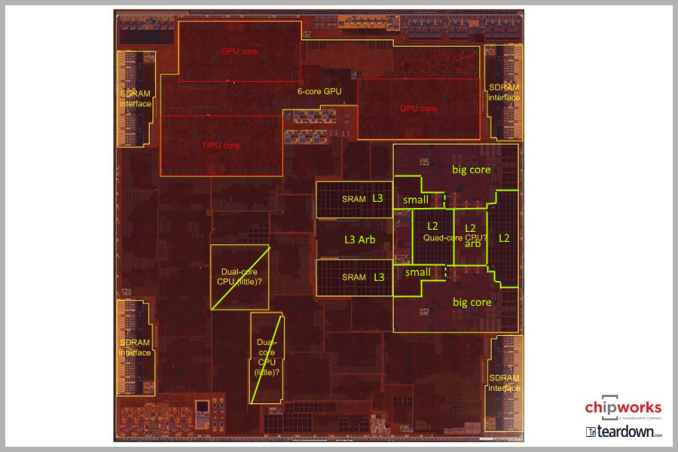
A10 Fusion's Floorplan (Special thanks to Chipworks)
While an in-depth look at A10 Fusion will have to wait until our seperate technology deep dive, we can still take a look at how performance has changed at a higher level. A10 Fusion's peak frequency is 2.3GHz, up from 1.8GHz on A9. This gives a theoretical improvement of 28% on its own, and the remainder will have to come from improvements to the architecture in Apple's (big) Hurricane cores. Based on our testing so far, Hurricane is not radically different from Twister (A9), but Apple has been making some optimizations. Meanwhile it should be noted that while A10 technically has four CPU cores – the two Hurricane cores and the two smaller cores – this is not a heterogeneous design, and only two cores are active at once. So for the purposes of high performance benchmarking, this means we're benchmarking the big cores nearly exclusively.
Anyhow, we've run our standard suite of benchmarks on the iPhone 7 and 7 Plus to see if A10 Fusion stands up Apple's performance claims.
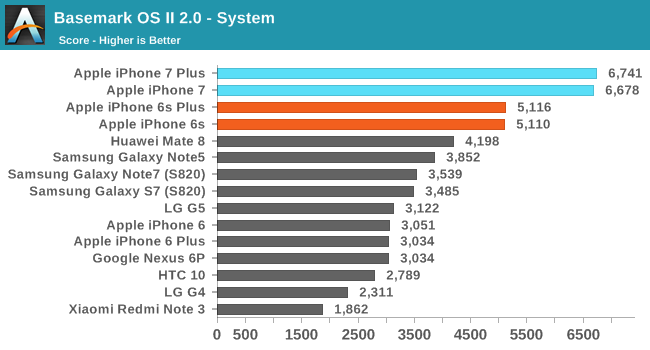
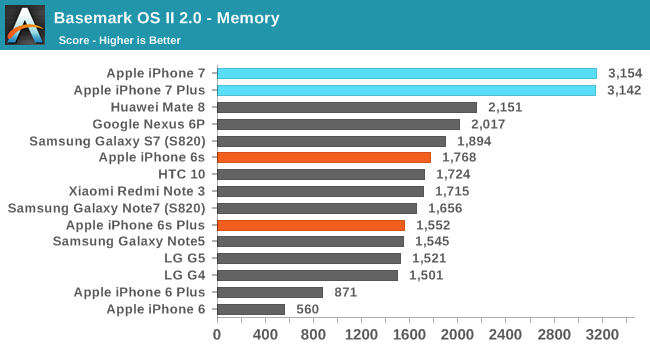
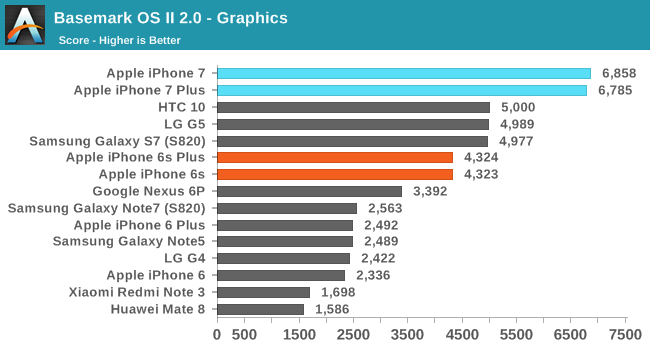
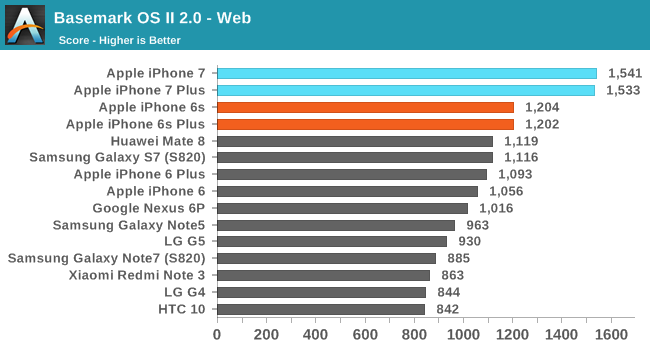

I've brought back BaseMark OS II for this review, although unfortunately the reason has less to do with wanting it back in the benchmark suite and more to do with there being very few cross-platform general system benchmarks nowadays. You can focus on the GPU, or the CPU, but the major system performance benchmark in mobile is PCMark and it remains exclusive to Android. BaseMark OS II is a pretty large optimization target now, and while it does test many aspects of the system it doesn't do so by directly simulating the tasks that a user would perform. Despite that, it helps in getting a holistic view of a device's performance by going beyond tests of a single component, so it's not without its uses.
The iPhone 6s and 6s Plus have remained the fastest overall devices in this test, so it's really just a matter of seeing how much Apple has improved. The latest generation of Android devices outpaced the GPU performance Apple's A9 SoC some time ago, so that's one area where Apple could stand to improve against the competition. As it turns out, they have. The iPhone 7 and 7 Plus show significant gains over their predecessors across the board. Performance in the system sub-test is up by 25-30%, and the graphics score is right in line with Apple's claimed 50% increase in performance. Web shows similar gains to system, which makes sense given that both are relatively CPU-bound.
The memory/storage test also shows a large improvement, which is interesting at first glance given that Apple didn't highlight any improvements in this area. However, this is just the result of the tested units being the 256GB model. On my retail iPhone 7 which is 128GB the memory score is essentially the same as the iPhone 6s which was also tested in a 128GB configuration. This comes down to the fact that these devices use a hybrid SLC/TLC storage solution, where the SLC storage can be used for writes and data can be moved later as needed. It's likely that on the 128GB iPhones the BaseMark OS II memory test is exceeding the size of the SLC cache, leading to lower scores based on the performance of the TLC NAND. On the 256GB iPhone the SLC cache is large enough to fit the entire data set used in the test, leading to a much higher score.
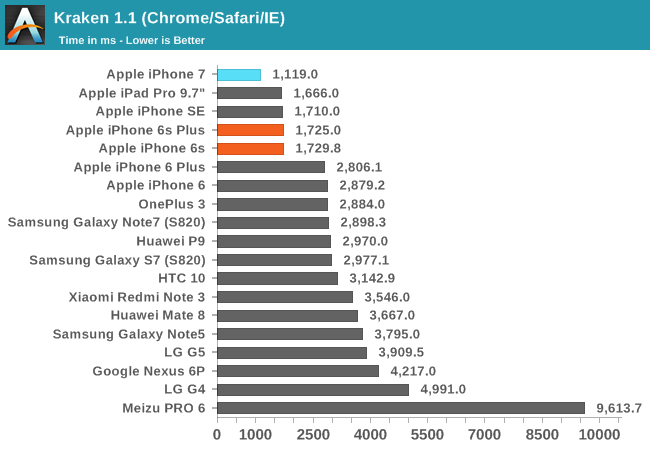
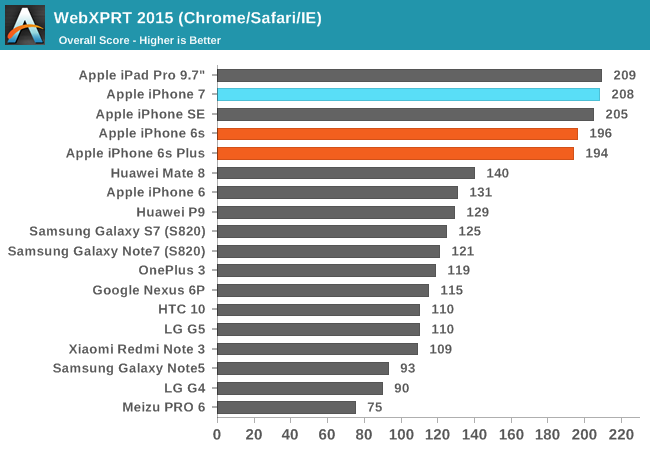
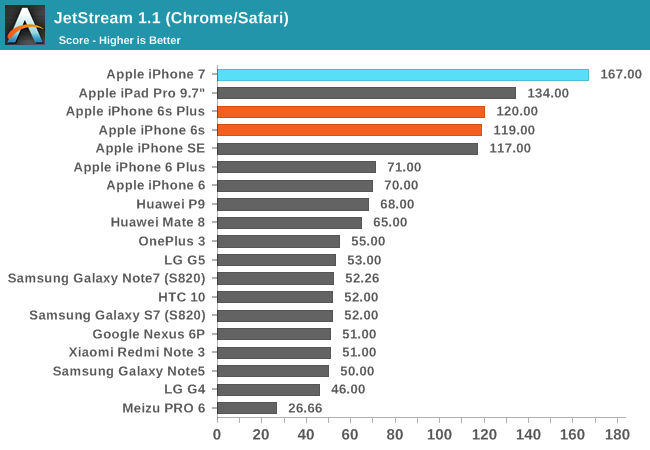
Web performance is an interesting case. While Apple's continued increases in single core CPU performance have benefited web performance with each generation, the truth is that improvements Mobile Safari's Nitro JavaScript engine have contributed a great deal as well. When looking at the charts you can see that there's a significant gap between the iPhone 7 and the next device, with the exception of WebXPRT where it's tied. What's more important than this gap is what the second device actually is. It's always another Apple device, and the same is true for the third device, and the fourth device, and so on. In Kraken and Jetstream the top seven devices on the chart are Apple's mobile devices, and the charts only have seven Apple devices in total. The Huawei Mate 8 is able to move ahead of the iPhone 6 in WebXPRT, but the gap between it and the iPhone 6s is still enormous. While Apple has continued to advance their web performance, it hasn't been with the immediate goal of beating the Android competition, as the best Android devices are still just trading blows with the iPhone 6.
WebXPRT is a small exception. As far as mobile benchmarks go, it's quite long and has short bursty workloads with pauses between each to simulate how a user would pause between different actions while using the browser. I suspect that in this case we're seeing the effects of A10 switching between its low power and high performance cores, causing parts of the test to be run on the little cores, which are not as performant. In fact, In the case of very quick actions that take only tenths or hundreths of a second to complete, it may not be possible to switch to the high performance cores before the operation has ended, causing the score to reflect the performance of the low power cores instead.
While it might seem reasonable to attribute the superior web performance of iOS devices to Apple's focus on improving single threaded CPU performance, the fact that Android devices with Cortex A72 CPUs are only matching Apple's A8 SoC shows that the gap is not only due to the CPU power available. Chrome's generally poor performance on Android is a significant limiting factor, and you can see in the chart how the improvement in Android device CPU performance over time has not translated into anything close to the sorts of gains that Apple has seen in the same period. While there are customized versions of Chromium like Snapdragon Browser that provide optimizations for a class of SoCs, it doesn't look like the gap between Android devices running Chrome and iOS devices running Mobile Safari is going to close any time soon, and if anything, it's only widening with each year.


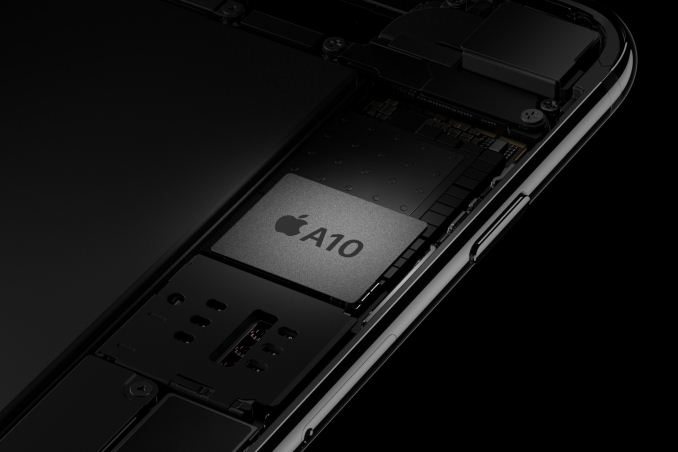








377 Comments
View All Comments
GTRagnarok - Monday, October 10, 2016 - link
Yeah, that statement made no sense. He said it was fairly thick relative to the iPhone 6S which was thicker at 7.1mm so...???lilmoe - Monday, October 10, 2016 - link
The whole thing about thickness and "freezing motion" made no sense. He probably didn't have anything else to prove his "point" that iPhones faced little competition in 2014/15.The context of AT reviews has been broken for a while. Just like someone else here suggested; they should only focus on reviewing parts of tech in which they have more knowledge about and accurate tools to measure. Hopefully using better "tools" than browser benchmarks (!).
Ryan Smith - Tuesday, October 11, 2016 - link
For better or worse, you will be seeing browser benchmarks for years to come. As few developers care to tackle cross-platform system benchmarks, we aren't left with very many tools to use. Never mind the fact that browser performance is still a major part of the overall smartphone experience.lilmoe - Tuesday, October 11, 2016 - link
Your perception and truth and credibility is up to you. But if it is worth anything, I'd suggest you change the title/section to "Mobile Safari Performance (vs Mobile Chrome)", or scratch it off entirely.What you're currently doing is provide false information (and lies) to your readers, unless the purpose of this site has changed to "providing fanboys and fools with fuel for their petty flamewars". You're making yourself look like an Apple shill, or worse, you're providing a cover up for Google's failings in optimizing their browser and platform for the latest Cortex and custom cores.
If you have no tools for accurate measurement, like you just stated, then you should skip this section all together or narrow it down to Apple SoC comparisons ONLY, with a big fat disclaimer explaining why that data CANNOT be applied/compared with other SoCs and platforms.
lilmoe - Tuesday, October 11, 2016 - link
***Your perception *of* truth and credibility is up to youblackcrayon - Tuesday, October 11, 2016 - link
Yes, they should have included GeekBench as a cross platform SoC test. THAT would have shown that... oops... The A10 still blows away everything else in single core by a huge margin.From what I've seen, using other browsers on Android doesn't help much. But if you'd like to point to some benchmarks we're all eyes.
UtilityMax - Wednesday, October 12, 2016 - link
The smartphone SoCs have reached a point where their performance differences are pretty much superfluous. Yeah, we all know that the Apple SoC is significantly better than Snapdragon 820. But that's just like saying that if you bring to a race track Lamborghini, Ferrari, and McLaren and race them, then you will find out that one car is fast than the rest, which is somewhat irrelevant outside of such racetrack. The truth is that smartphone SoCs have gotten to be fast enough that a three year old Nexus 5 is still fast and more than adequate for day to day duties. On the other hand, apple's deletion of the headphone 3.5mm jack and its refusal to allow the users to upload the multimedia into the device bypassing the iTunes GARBAGE is a big loss. For these reasons, in my book, a 200USD Moto G is still a lot better than an iPhone 7, even if the iPhone 7 was also sold for 200USD.ex2bot - Wednesday, October 12, 2016 - link
I can get the multimedia to my Apple phone without the iTunes GARBAGE. Maybe you have a different model from me or something. ;)CloudWiz - Thursday, October 13, 2016 - link
Which is why both XDA and Anandtech have found that the Note 7 was incredibly slow to load apps in Discomark, which definitely impacts daily usage.ex2bot - Wednesday, October 12, 2016 - link
Forget GeekBench. Stick with Antutu. More representative.